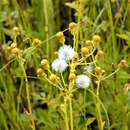Comments
provided by eFloras
Ecologically and morphologically, Packera paupercula is the most variable species of the genus in North America. Some "phases" have been treated as separate species, subspecies, varieties, forms, and races. Variation within P. paupercula hints at some interesting evolutionary relationships; characteristics used to separate taxa overlap. Much of the morphologic variation in this species may be due to hybridization and introgression. I do not recognize any of the infraspecific taxa that have been proposed.
- license
- cc-by-nc-sa-3.0
- copyright
- Missouri Botanical Garden, 4344 Shaw Boulevard, St. Louis, MO, 63110 USA
Description
provided by eFloras
Perennials, 20–45+ cm; subrhizomatous (bases weakly branched, ascending to erect). Stems 1 or 2–4, loosely clustered, glabrous or sparsely tomentose proximally. Basal leaves petiolate; blades lanceolate to narrowly elliptic or oblanceolate, 30–60+ × 10–20+ mm, bases tapering, sometimes obtuse, margins subentire to dentate or serrate. Cauline leaves gradually reduced (proximals petiolate, sublyrate; mids sessile, not clasping, lanceolate, dissected, incised, or lacerate; distals sessile, bractlike). Heads 2–10+ in loose or compact, corymbiform arrays. Peduncles usually bracteate, sometimes ebracteate, glabrous. Calyculi inconspicuous. Phyllaries 13 or 21, green, 5–8+ mm, glabrous. Ray florets 0, 8, or 13; corolla laminae (pale yellow) 5–10+ mm. Disc florets 50–65+; corolla tubes 2–3 mm, limbs 2–3 mm. Cypselae 1–2 mm, usually glabrous, sometimes hispidulous on ribs; pappi 3.5–4.5 mm. 2n = 44, 46, 92.
- license
- cc-by-nc-sa-3.0
- copyright
- Missouri Botanical Garden, 4344 Shaw Boulevard, St. Louis, MO, 63110 USA
Synonym
provided by eFloras
Senecio pauperculus Michaux, Fl. Bor.-Amer. 2: 120. 1803; S. balsamitae Muhlenberg ex Willdenow; S. balsamitae var. firmifolius Greenman; S. balsamitae var. thomsoniensis Greenman; S. crawfordii Britton; S. flavovirens Rydberg; S. gaspensis Greenman; S. multnomensis Greenman; S. robbinsii Oakes ex Rusby var. subtomentosus Peck; S. tweedyi Rydberg
- license
- cc-by-nc-sa-3.0
- copyright
- Missouri Botanical Garden, 4344 Shaw Boulevard, St. Louis, MO, 63110 USA
Packera paupercula: Brief Summary
provided by wikipedia EN
Packera paupercula is a flowering plant species of the genus Packera and family Asteraceae, native to North America, where it is widespread across Canada and much of the United States. Its common names include balsam ragwort and balsam groundsel. It is a perennial herb that grows 1–3 feet (0.30–0.91 metres) tall. Its habitats include wet meadows, open woodlands, and rocky outcrops.
It flowers as early as April in the southern part of its range, and as late as August in the northern part of its range.
- license
- cc-by-sa-3.0
- copyright
- Wikipedia authors and editors

